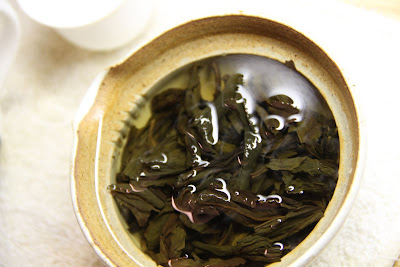A mention of this tea on Twitter from Greg at
Norbu Teas perked my interest right away.
It is unconventional, not highly accessible, and it was the first time I had heard of such a tea.
Growing tea in shade is very common in Japan, and gives the vibrant green color all so familiar to those who drink matcha, gyokuro, or sencha.
So basically take your average, nuclear green (so affectionately named by some bloggers) , Anxi TGY, and make it even
more green. At this point, it might be referred to as radioactive green.
But all sarcasm aside, this tea is truly unique.
Some might consider this a grassy tea, but the aroma displays more characteristics than just that.
The dry leaf smells highly floral, fresh, and has a distinct minty evergreen trait to it.

The aroma coming off of the liquor smells much sweeter, and less like vegetation.
Honey scents mix with lemongrass, and collide with the same evergreen characteristic that was evident in the dry leaf.
The higher concentration of amino acids and chlorophyll really do bring out quite different attributes than a standard TGY.

A sweet, rich, evergreen tasting liquid is the final product of the leaves.
It is well rounded, just floral enough, and has very low astringency. This comes as a bit of a surprise to me, seeing as Japanese teas can have quite high levels of astringency, and this tea does, in some ways, bear resemblance to a sencha or bancha. I suppose the difference would be that this TGY was not steamed.
Another interesting quality of this tea is that it is very "wet." It does not dry out the mouth, but rather it induces the production of saliva.
After the fourth and final infusion was finished, a very vegetal aftertaste presented itself, conjuring up tastes most closely resembling spinach. It was a clean finish, however.

This tea is very crisp. It is not smooth and creamy in texture, but has sharp, distinct flavors.
The tea is lacking in endurance, although I did not use quite so much dry leaf as I should have (just a personal preference). It lasts long enough for a pleasing session, though!
I would buy this tea again, and I would recommend it for anyone looking for something a little off the beaten path.
~billy

















































